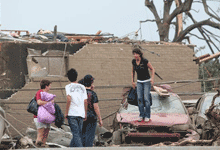Meteorologist James Spann could tell from his radar screen that Tuscaloosa, Ala., was in the path of a powerful storm Wednesday. But when his TV station, ABC 33/40, turned one of its cameras (mounted on the County Courthouse) and then one of its tower cameras toward the storm, he could hardly believe what he was seeing.
-

- Residents attempt to retrieve their belongings after a tornado destroyed their apartments Wednesday, April 27, 2011 in Tuscaloosa, Ala. (Caroline Summers/AP)
A mile-wide funnel cloud touched down and blasted through the city while Spann calmly and factually tracked its path through the area where he grew up and started his broadcast career while in high school. His intimate experience with Tuscaloosa was apparent as he named, street by street, where the storm was moving.
He was not just on local TV. The station streamed the signal live online through UStream and the station’s website. Even while he was live on the air, Spann and his team constantly updated his 24,000+ Twitter followers and the station’s more than 20,000 Facebook fans (More than 53,000 have liked Spann’s Facebook page).
Viewers inundated Spann’s Facebook page, including out-of-staters who depended on UStream and Twitter to share information with family in the state who had no electricity or cable TV.
Before dawn Thursday, Spann was tweeting and updating his Alabama Weather blog, anticipating the community’s needs. He wrote:
“I will attempt later today to put together some video highlights from yesterday; the tornadoes captured by our SKYCAM network and Skywatchers in the field were breathtaking. Our helicopter will be up at the first light of day, so be sure and watch ABC 33/40 throughout the day for news coverage. You can see thousands of images and videos on our Flickr feed here.”
“THE DAYS AHEAD: We will write much more about the outbreak later, but this discussion is designed to let you know what the weather will be in coming days, and the news is good. Cooler and drier air has moved into Alabama, meaning today will feature a good supply of sunshine with a cool breeze and much lower humidity.”
The Facebook page became a gathering place for an outpouring of grief, for locals to find out which schools were closed and during the storms, or to just say “thank you” to a TV station that they say saved lives.
Spann has used multiple platforms to cover severe weather before, as Lost Remote’s Cory Bergman notes. (Bergman is a member of Poynter’s National Advisory Board.)
Earlier in the day Wednesday, Spann was on the air live with images of a powerful tornado tearing through Cullman, Alabama.
On December 16, 2000, an F4 storm blasted through Tuscaloosa and the station once again captured the storm on a tower camera.
Spann was live on the air in November 24, 2001 during what was, until now, considered the worst swarm of storms to hit the state.
Please share links to other coverage of the Alabama and southern storms. You can post them in the comments or email them.













Comments